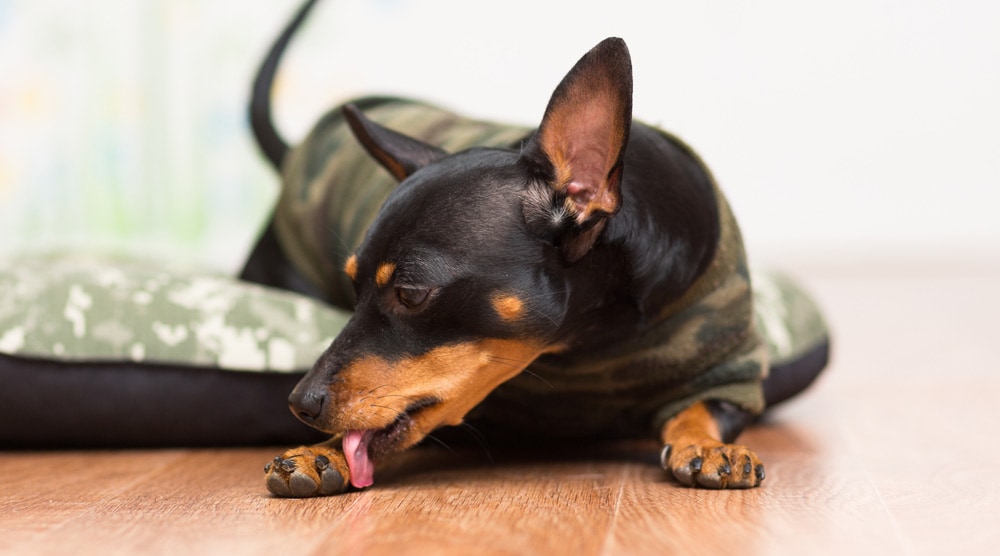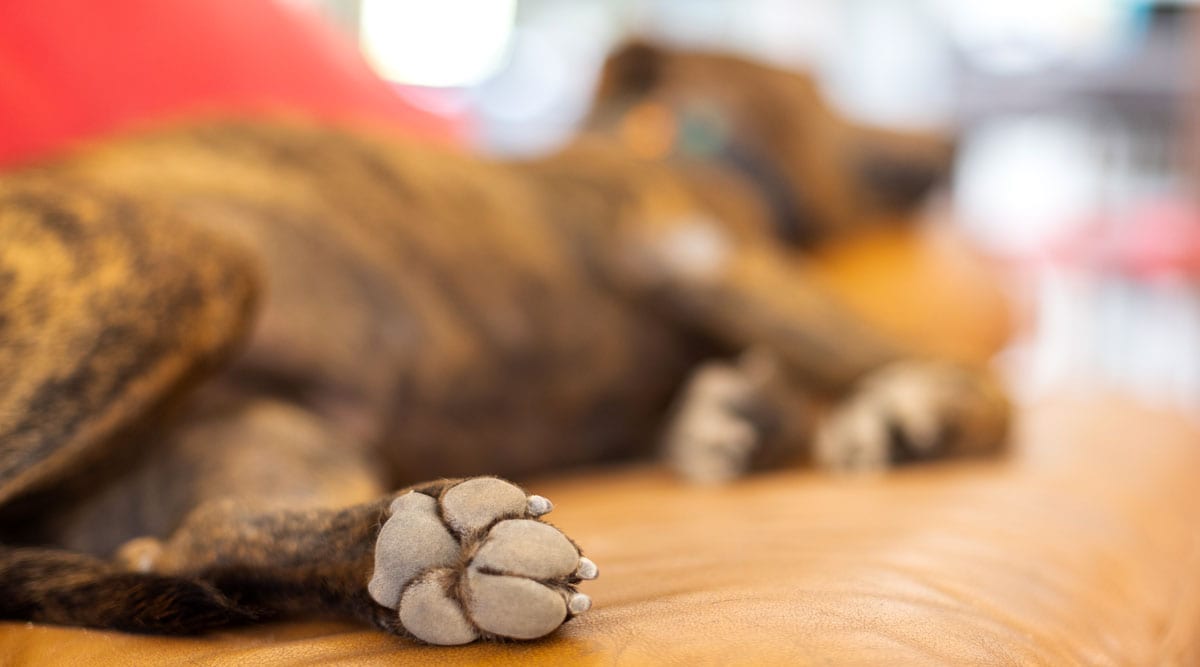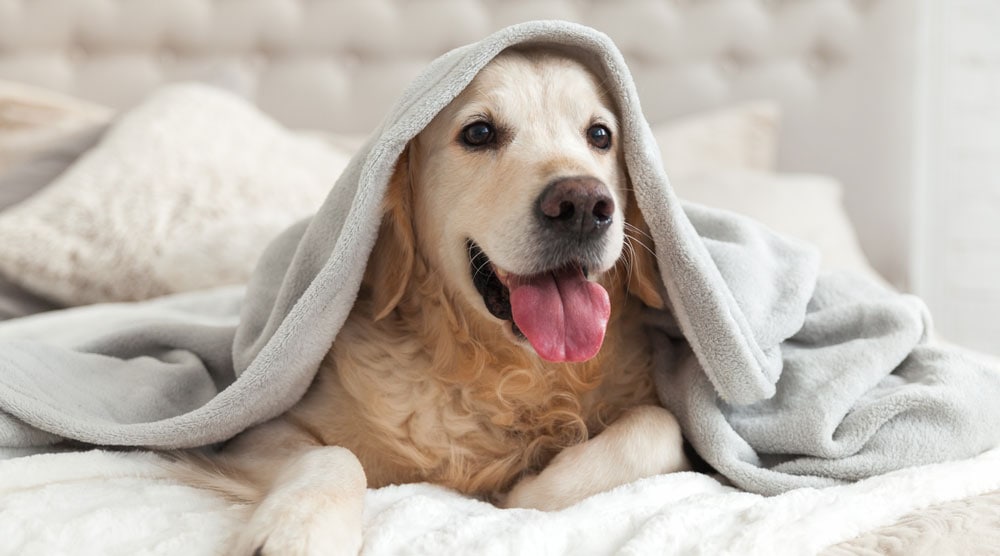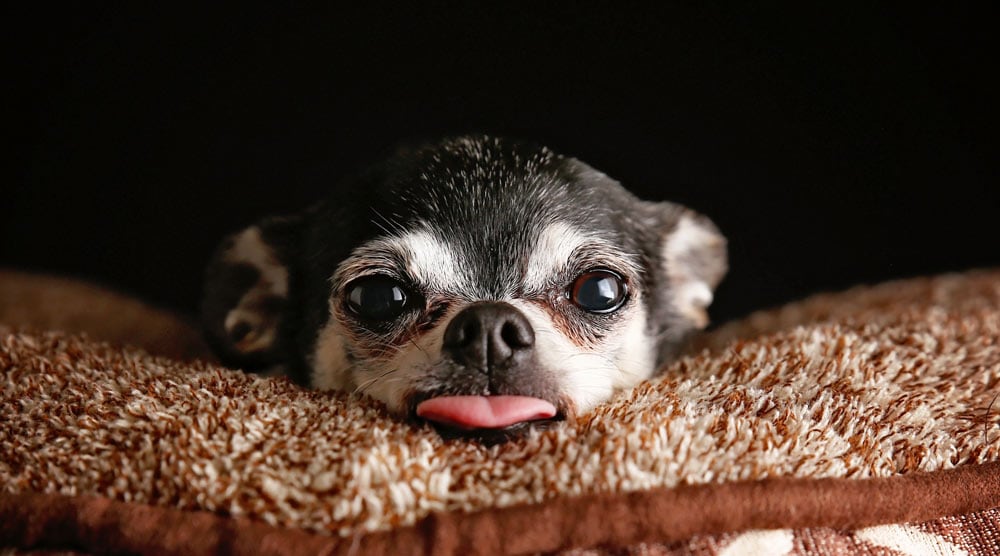The occasional paw lick is probably nothing to worry about. It might not seem hygienic by human standards, but licking is a natural behavior that dogs use for self-grooming and cleaning.
Repeated or excessive licking is often a sign of an underlying problem though. Dogs lick their paws for many potential reasons, so diagnosing the issue often requires professional help. Examples include pain, injuries, medical conditions, anxiety, and psychological issues.
If you notice your dog licking his paws a lot, contact a vet as soon as possible. Allowing it to continue could lead to further problems and even risk a secondary bacterial infection. Over time, licking can also become an obsessive behavior if it isn’t addressed.
In this article, we’ll look at the most common reasons for excessive paw licking. We’ve also provided some tips for relieving the problem, depending on what’s causing it.
Contents
Why Do Dogs Lick Their Paws?
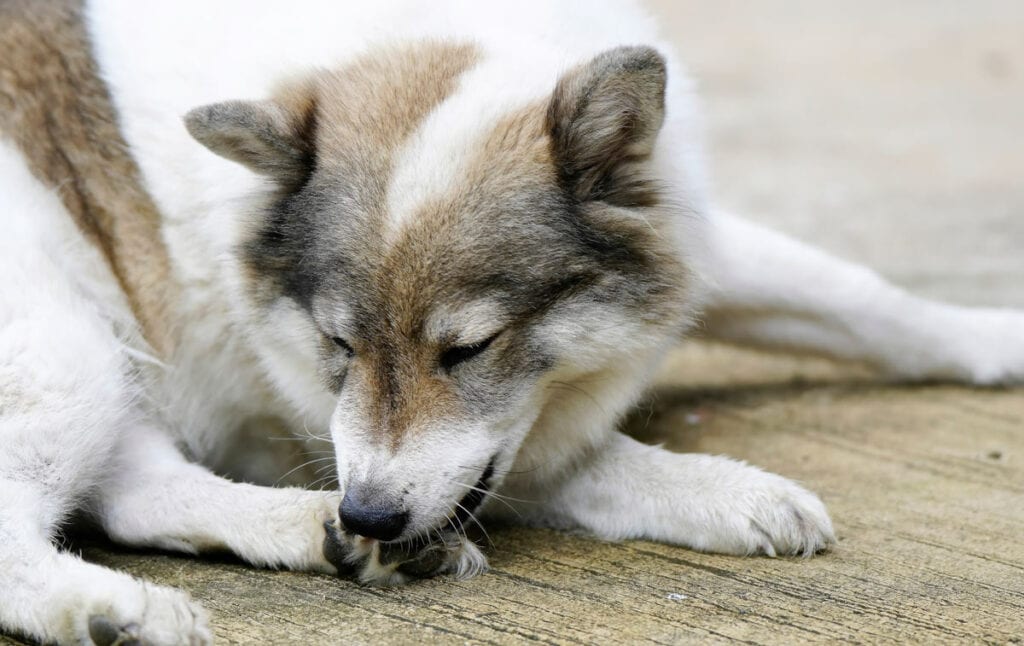
Most dogs lick their paws a little now and then to keep clean. Unlike cats, however, dogs don’t tend to be fastidious self-groomers. This means that lengthy paw licking or gnawing is usually a sign there is something wrong.
Although there are many reasons why your dog may be licking their paws a lot, they typically fall into one of the following categories:
- Pain or irritation
- Anxiety or stress
- Illness
By licking their paws, dogs are often trying to relieve itching, reduce discomfort, or distract themselves from stress or pain. Treatment varies a lot depending on the underlying reason, so it’s important to get an accurate diagnosis.
Why is Excessive Licking Something to Worry About?
For something seemingly so innocuous, frequent paw licking can greatly impact the quality of your dog’s life.
That’s why it’s always a good idea to consult with a vet about excessive licking. This is especially true if it starts suddenly and is accompanied by other symptoms. Things like swelling of the paw, limping or itching are tell-tale signs that something’s not right.
“Canine skin is quite robust, but it’s not designed to be licked compulsively,” says vet Dr Linda Simon. “This behavior will soon cause microscopic and then visible damage.”
If allowed to continue, licking can lead to hair loss, stained fur (due to proteins in the dog’s saliva), hot spots, and irritation.
The dog may also develop painful and fast-growing lesions, called “lick granulomas”. Once established, these take a long time to heal and treatment can be tricky.
Another problem is that licking can become a vicious cycle. The bacteria in your dog’s mouth and open skin can lead to skin infections, and this can make your dog lick their paws even more. In some cases, the act of licking can also become a self-reinforcing habit.
For these reasons, you should never ignore excessive licking. The sooner you seek professional help, the faster you can resolve any stress, pain, or discomfort your dog is experiencing.
Excessive Licking Causes Progressively More Severe Symptoms
To illustrate how serious excessive licking can be, here’s Dr Linda Simon’s breakdown of what happens to your dog’s skin and fun:
- Licking initially causes saliva stains on the fur and skin (these are more obvious on white-furred dogs.)
- A short time later, the fur becomes damaged and breaks off.
- The next step is the skin barrier breaking down, allowing allergens and dirt/bacteria to enter the skin.
- This leads to local inflammation and mild swelling, so the skin may appear pink.
- As the skin barrier breaks, you’ll also notice scabs forming and crusted lesions.
- As infections develop, the paw may start to ooze and smell. There can also be a small amount of bleeding.
“We can prevent the above by addressing the underlying cause of licking, while reducing licking with distraction techniques, medication, and tools like buster collars,” adds Dr Simon.
Related Article: What Causes a Dog’s Fur To Change Color In Spots?

Temporarily Limit Licking to Prevent Further Irritation
While you find out why your dog is licking, it’s important to minimize any further damage. Some examples of management strategies can include:
- Inflatable Buster or Elizabethan collar. When properly fitted, these can be the most effective method for preventing your dog from licking their paw. For stressed dogs, however, these collars may heighten anxiety. You will need to spend time getting your dog relaxed when wearing one.
- Bandages/boots or socks. Although these can be a good alternative if your dog won’t accept an Elizabethan or inflatable collar, they aren’t suitable in all circumstances. If your dog is licking a wounded area or one that has an open sore, this type of cover won’t allow for adequate healing, especially if it’s tightly fitted. It’s also important to keep bandages from becoming wet and changing them if they get grubby. Determined dogs, when left alone, will be able to remove a bandage. “I often advise against covering the paw,” says Dr Linda Simon, a veterinary surgeon. “Dogs sweat through their paws, creating a moist and humid environment that can lead to more itching and even infection.”
- Anti-lick strip. These can have mixed success, as some dogs aren’t repelled by the taste and will lick regardless. They should never be placed over any wound.
- Distraction and enrichment. For some dogs, especially if the licking is behavior-related, it can be enough to keep them occupied with other things. Offering treat toys, extra training, and even rewarding them when they stop licking are all worth trying. “I find the best distractions are those that incorporate licking, which many dogs find soothing,” says Dr Linda Simon. “I’m a big fan of lick mats, which can be smeared with a range of foods including wet dog food, mashed sweet potato, and peanut butter.”
Be aware that the “right” management strategy depends on the reason for licking and your dog’s temperament. Don’t forget that these are only meant to be temporary tools.
10 Reasons Your Dog May Lick His Paws
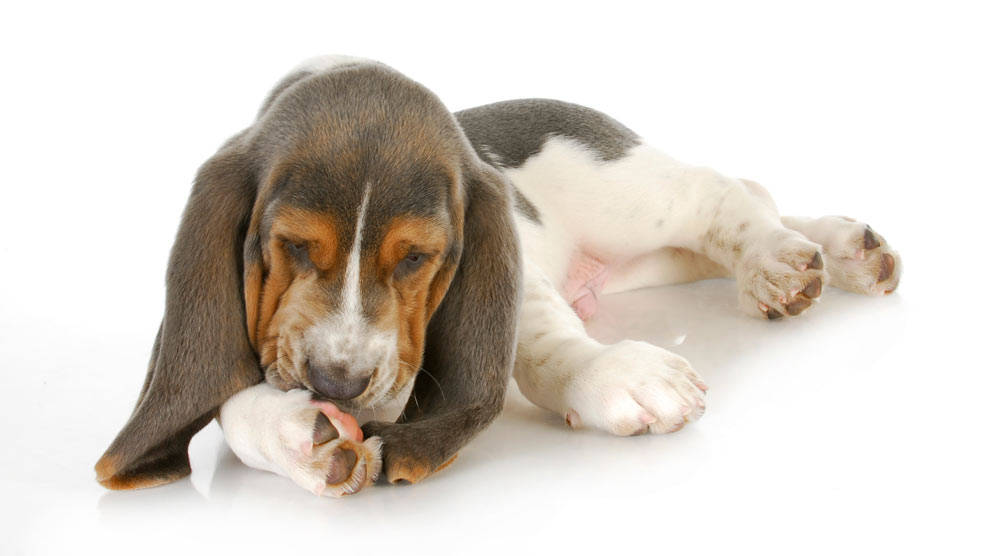
Sometimes, it’s obvious why your dog is licking. For example, if she has a cut on the paw or matted fur, it’s often easy to identify the issue.
This isn’t always the case though. Many reasons for excessive paw licking are subtle or difficult to spot. The issue may not even be related to paw itself, which makes identification even more tricky.
To help you uncover the problem, here are some of the most common reasons for excessive paw licking. This article isn’t meant to replace investigation by a vet or qualified dog behaviorist though.
1. Environmental Allergies
Airborne allergies are thought to be the most common cause of excessive paw licking in dogs. Seasonal allergies from pollen and grass are the most frequent offenders. Dust, mold, and fungi can also be culprits, along with cleaning products and laundry detergents.
“I see paw licking most commonly in dogs with underlying allergies,” says vet Dr Linda Simon. “Some owners are so used to their dog licking that they don’t see it as an issue. It can take some convincing to get them to realize that paw licking to this extent is not normal!”
Your dog may feel itchy all over, but it’s usually the ears, bottom, and between toes that are most aggravated. Some allergies are seasonal, while others are triggered throughout the year.
“Yeast overgrowth, a condition often linked to allergies, can also cause paw licking,” adds Dr Simon. “Owners may notice red skin and a musty smell coming from the paws.”
Human allergies are commonly triggered by inhalation, but dogs tend to have flare-ups when the allergens are absorbed through the skin and paws. Grass and pollen, which often come into contact with the paws, are probably the most likely to cause paw licking.
Even so, an allergen doesn’t necessarily need to touch the paws to cause itching, discomfort, and ultimately paw licking.
Keep in mind that allergies can develop as a puppy gets older. “Owners often first come to me when their dog is between 6 months and 3 years old,” says Dr Linda Simon. “These dogs can develop new environmental allergies to substances they previously tolerated. So, the age and breed of the patient are two things we take into account when determining the cause of paw licking.”
Note: Some breeds are genetically predisposed to allergens in their environment. Examples include Golden or Labrador Retrievers, Boston Terriers, Spaniels, Frenchies, Boxers, Bulldogs, and West Highland Terriers.
Tips for Relieving Environmental Allergies
As there are many potential allergens, the first step is to do a little detective work. Does the allergy get worse in certain seasons? Do you notice flare-ups after walking? Have you recently started using a new cleaning product in the home? Or have you washed their bedding in a new laundry detergent? Are there other symptoms, such as a runny nose? These types of questions can help your vet diagnose the allergy.
Once you’ve identified what’s causing the allergen, the goal is to minimize your dog’s contact to reduce the chance of a reaction.
However, for dogs who are allergic to pollen or grass, it can be tricky to keep your pet away from triggering allergens. You can try to change your walking route to avoid fields with lots of pollen-heavy flowers. It’s also a good idea to avoid walking during the middle of the day when the pollen count is at its highest.
Cleaning your dog’s paws after a walk can also help to remove any allergens lingering on the fur between their toes.
Although you don’t want to bathe your dog too often, you can try using an anti-itch shampoo to moisturize dry skin and soothe inflammation.
For severe flare-ups, you should speak with your vet to discuss whether antihistamines, topical solutions, or other medication may be beneficial for your dog.
2. Food Allergies
Food allergies aren’t as common in dogs as environmental allergies, but they’re still a possible cause of paw licking.
“Food allergies cause itching and inflammation as the body reacts to the allergen in their diet,” says Dr Linda Simon. “The immune system sees the food as a ‘foreign invader’, leading to an abnormal immune response. This skin inflammation creates intense itchiness, which dogs cope with by scratching, chewing, and licking.”
Along with itchiness, food allergies can cause gastrointestinal symptoms, such as chronic stomach upset and bloating. “Food allergies can also cause a red muzzle, red anus, and anal itching. More severe food allergies may even lead to hives and facial swelling,” adds Dr Simon.
The most frequently reported foods that cause reactions in dogs include beef, dairy products, wheat and chicken. Of course, this could be because these are all common dog food ingredients.
“New food allergies can develop at any age between approximately six months and five years. So, we can’t rule out food allergies, even if your dog hasn’t changed their diet,” says Dr Simon.
Tips for Relieving Food Allergies
Diagnosing an Adverse Food Reaction (ADF) can be tricky, and simply swapping to a “hypoallergenic” food will rarely be a solution. While many of these foods contain a simpler list of ingredients, your dog could still be allergic to any of them.
Allergy testing is often viewed as a simple solution. However, dog hair and saliva allergy tests have been proven to be largely inaccurate and not the best way to identify allergens.
A vet can also run allergy blood tests. These are more accurate than saliva or fur tests, but cost a lot more.
Carrying out an elimination diet is widely recognized as the only reliable way to diagnose a specific food allergy in dogs. It’s time-consuming, and you need to be strict, but, in the long term, it could be worth it.
An elimination diet is highly restrictive, so it should only be done with the assistance of a vet. This process involves removing all food sources and putting your dog onto a limited-ingredient diet. This diet will consist of a novel protein and carbohydrate source that they haven’t had before.
In many cases, your dog will eat a veterinary-prescribed hydrolyzed single protein diet. Alternatively, you can prepare a carefully selected minimal ingredient home-cooked option.
The dog should be on this diet for at least eight to twelve weeks. It can take several weeks for the effects of the previous food to leave their system. Food types are then slowly re-introduced, one by one, until the offending allergen is found.
While on an elimination diet, being strict is essential. If your dog gets an occasional treat or snaffles something while out on a walk, this can impact the results. All your hard work and weeks of patience can be wasted if this happens.
3. Pain
Pain is a common reason for paw licking. Sometimes the pain is localized to the paw itself, but licking can also be a way to distract from pain elsewhere in the body.
If your dog is always licking just one paw, it’s unlikely to be related to allergies or other systemic problems. Instead, there is probably an issue with that specific paw.
Some common causes of pain in a single paw can include:
- A fractured dewclaw
- Corns
- A cut pad
- Excessively long nails
- Cracked pads
Paw licking can be caused by pain in other areas of the body, although this often results in licking of both paws. Even problems such as sore joints can cause your dog to lick their paw in an effort to soothe or distract from the pain.
Dogs suffering from arthritis, for example, lick their paw and the bottom of their leg more frequently. If your dog is experiencing dental pain, they may also lick to relieve the pain in their mouth.
Less commonly, autoimmune diseases and interdigital cysts or growths can result in your dog licking their paws.
4. Anxiety
Studies have shown that the act of licking can be stress-relieving for dogs. This is because licking releases hormones called endorphins, which help your dog feel happier.
To establish if your dog is feeling anxious, you should watch their body language and check for other changes in their behavior. Some common signs of stress include:
- Excessive panting
- Pacing
- Drooling
- Anxiety signals like yawning, shaking, sneezing or lip licking (including licking the air)
- Changes in mood
- Stomach upsets
- Destructive behavior
If you notice stress signals, try to identify the trigger. Are there visitors in the house? Can your dog hear unusual noises? Have there been any changes in circumstances, such as a new pet, baby, or house? Once you’ve identified the trigger, removing it can help to reduce paw licking.
It’s not just acute stress that can cause paw licking though. Long-term stress in dogs can lead to obsessive-compulsive behaviors, including paw licking.
In extreme cases like this, it’s essential to discuss a behavior modification program with a qualified behaviorist. This will sometimes be combined with medication from a vet.
“I find anxiety is more often the culprit in high-energy working breeds such as the Border Collie and Belgian Malinois,” says vet Dr Linda Simon. “These dogs are often not given enough mental and physical stimulation when living in a family home environment.”
Tips for Reducing Anxiety
Once you identify the trigger for your dog’s anxieties, the best option is to remove it. If this isn’t possible, gentle counterconditioning and desensitization techniques can reduce anxiety.
Some other tips for reducing anxiety include:
- Try to stick to a consistent routine. This helps many dogs to feel relaxed and settled.
- Make sure your dog always has access to a comfortable “safe space”, such as a crate or bed. Make sure everyone in the house respects your dog’s space, especially when he’s eating and sleeping
- Complementary therapies like flower essences, body wraps and dog appeasing pheromone plug-ins can sometimes reduce anxiety.
- Slow and “sniffy” walks can help make your dog feel more relaxed and positive.
Licking can also be caused by a lack of exercise or mental stimulation. Some dogs use licking as a way to relieve boredom, which can also become a habit.
Making sure your dog gets plenty of physical activity and in-house enrichment is vital. If you’re struggling for inspiration, check out our articles for indoor activities for your dog and some more general fun things you can do with your dog.
5. Displacement Behavior
Dogs will offer displacement behaviors when they’re struggling with internal conflict, frustration or anxiety. These occur when a dog suppresses the urge to follow through with a particular behavior.
Displacement behaviors are usually normal behaviors in an out-of-context situation – and paw licking is a common example.
For example, a dog feeling trapped by a child may have the urge to move away. Instead, they start to lick their paws as a displacement behavior. Your dog may also do this if they are feeling nervous about strangers in the house, or if you’re trying to teach a command and they aren’t sure what you expect.
Displacement behaviors are often accompanied by other symptoms of stress. These can include scratching, yawning, lip licking, and looking away. As these behaviors are a sign that your dog is anxious or uncomfortable, they shouldn’t be ignored.
6. Matted Fur
Some breeds have long hair that grows between their toes. It’s tricky to brush this out, so it can often be accidentally neglected when grooming, leading to matting.
As these mats become thicker, they get tighter and can pull uncomfortably on the skin. In extreme cases, they can cause the skin to open up, and infections can develop.
Your dog may begin to lick around their paws more as these mats develop, in an effort to relieve the discomfort it’s causing.
For long-haired dogs, it’s always a good idea to check between their toes as part of your grooming routine to make sure knots aren’t forming.
7. Parasites (Fleas, Mites or Ticks)
A variety of dog parasites can cause uncomfortably itchy skin. This can lead to licking and nibbling across the body, but the paws are often an area of focus.
Flea allergy dermatitis is the most common parasitic cause of itchiness for dogs. Although it often causes itchiness around the tail region, the paws can sometimes be uncomfortable too.
Some of the other types of parasites that can result in itchy paws include:
- Sarcoptic mange. This is caused by a contagious skin mite that burrows into the skin. It’s also referred to as scabies, and extreme itchiness, scabs, and hair loss are common with this condition. The mites have a preference for hairless skin, so the ears, elbows and tummy are often worst affected, but it can still cause your dog to lick their paws.
- Demodectic mange. All dogs carry a small number of demodex mites in their hair follicles. These can spread rapidly in young dogs, or those with compromised immune systems. Cases can be localized or across the body. While demodectic mange doesn’t cause the itchiness that is common with sarcoptic mange, sores, crusting and swelling are common. This discomfort can compel your dog to lick the affected areas.
- Ticks. Ticks can tuck themselves away between your dog’s toes or pads. This could cause discomfort and result in the dog licking their paws more than normal. Swift and careful tick removal will minimize the risk of a tick-borne disease, like Lymes, being transmitted.
Identifying what kind of parasite is causing a problem for your dog often requires assistance from a vet. Prompt treatment is advised, and other pets in the household and also the immediate environment may need to be treated.
Making sure you keep up with regular antiparasitic treatments can help minimize the risk of ticks and fleas.
8. Grass Seeds
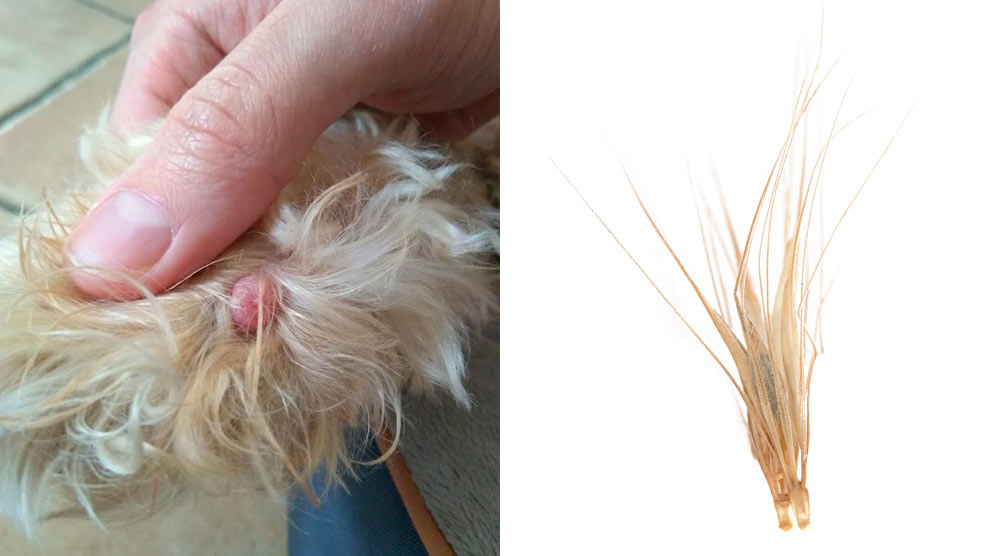
You may be surprised to learn that something as innocuous as a little grass seed can be a serious health hazard for your dog if left untreated. These little pods can burrow into the skin and migrate to other parts of the body, leading to a number of scary health problems.
One of the most common places for grass seeds to get stuck is the delicate skin between the toes. This can cause intense discomfort once the seed starts to burrow into the skin, leading to almost obsessive licking in an attempt to relieve the pain.
The problem might not be noticeable until your dog starts to lick the area. Look out for redness, swelling, or a small lump, as these could be signs that the seed has begun to burrow into the skin.
It’s a good idea to check your dog after a walk in an area with tall grass, especially during the summer months. Pay close attention to the toes and behind the ears.
Seeds that are caught in the coat should be swiftly removed. If you find a seed that is already partway into the skin, or you suspect it has already traveled further in, don’t try to remove it yourself. Make an appointment at the vet immediately.
9. Puncture Wounds
Adventurous dogs can suffer from cuts, scrapes, and punctures on their paws. Common culprits include thorns, splinters, jagged rocks, glass, and dog or insect bites.
Sometimes, you might not even realize your dog has an injury until you see them licking their paw.
A little licking isn’t necessarily a bad thing. This natural behavior can help to stimulate blood flow, and studies have shown that dog saliva has some antibacterial properties.
Too much licking, however, can open the wound and result in dirt or bacteria getting in.
For minor puncture wounds, ask your vet how to clean the affected area. You’ll then need to ensure your dog isn’t able to keep licking to ensure it heals. If your dog has a deep puncture or one that looks inflamed or swollen, visit your vet immediately.
10. Nausea or Gastrointestinal Issues
A study has shown that excessive licking of surfaces could be attributed to underlying gastrointestinal issues. It’s thought the behavior occurs in an effort to control the nausea or discomfort.
Although the studies focus on licking surfaces, it’s reasonable to assume that dogs could also lick their paws for the same reason.
If your dog is displaying signs of tummy discomfort, diarrhea, vomiting or excess salivation alongside their paw licking, a trip to the vet is recommended.
A Vet Checkup is Essential for Excessive Paw Biting or Licking
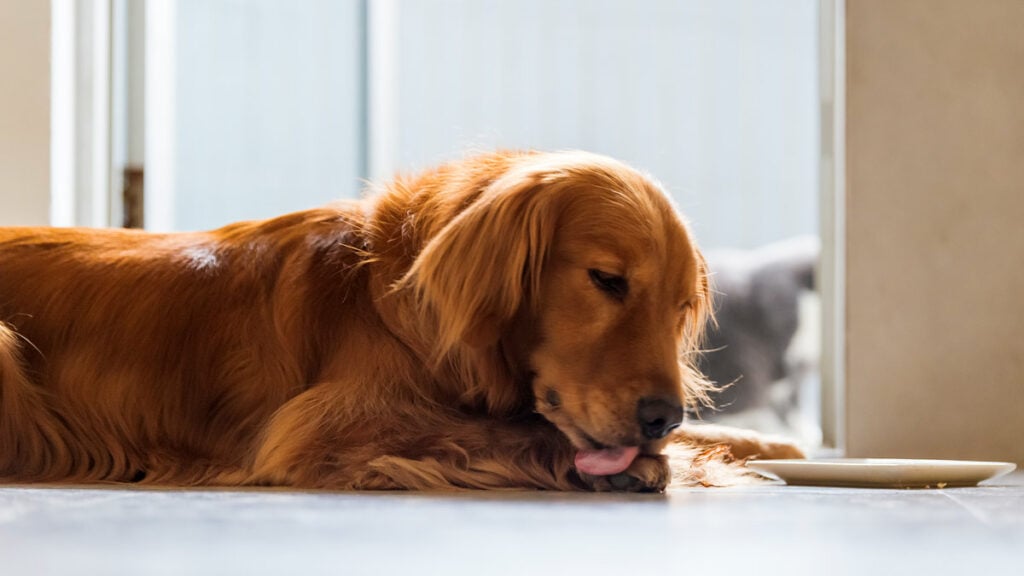
Excessive paw licking isn’t something that should be ignored. Not only can it lead to skin irritation, discomfort and possible infection, but it can be a symptom of a more serious underlying problem.
“I always emphasize that we need to identify why the dog is paw licking,” says Dr Simon. “Until the condition is diagnosed and treated, the paw licking will continue to flare up regularly.”
The sooner you get your dog to the vet for assessment, the better. Your vet will thoroughly examine the paw to rule out any foreign body or injury as the cause. They may also need to prescribe medication if a secondary infection has developed.
“Owners often turn to the internet to find a product that claims to stop itching and eliminate skin issues. This may be an over-the-counter supplement, wash, tablet, or cream. However, these products never identify the underlying cause of the licking and, even if they help, the effect tends to be temporary.”
If there’s no obvious underlying condition or cause, your vet may recommend running some tests. They may also ask you to monitor your dog’s behavior.
While tests are being run or a course of meds is being administered, your vet may recommend that you use a Buster Collar or similar. This will help to prevent your dog from doing further damage.
“If your vet is struggling to control the symptoms or pinpoint the cause of paw licking, consider a referral to a canine dermatologist,” says Dr Simon.

Perseverance is Key: A Vet Story About Paw Licking
“One patient I will always remember was a female English Bull Terrier called Lola. She had the sweetest nature, but suffered from terrible allergic skin disease and paw issues. She was in a lot of discomfort from her itchy paws, ongoing infections and interdigital cysts.”
“This poor girl was in several times a month as we tried to manage her infections, identify her allergies and control her signs. She must have been in a lot of discomfort but always had a lick and waggy tail for me as I examined her paws and whenever I ran diagnostic tests.”
“We eventually managed to control her signs through a combination of diet, supplements, medication and medicated washes but it was a journey to get there!” – Dr Linda Simon, Veterinary Surgeon
Frequently Asked Questions
Dogs often groom themselves after eating a meal, and sometimes they’ll focus on licking their paws. It can be seen as a ritualistic behavior, or sometimes they may be trying to remove excess food from around their mouth.
There are no studies to confirm why this is such a common behavior. However, if this is the only time your dog is licking their paws and it isn’t excessive, it shouldn’t be something to worry about.
If your dog is regularly licking their paws, it isn’t unusual for the fur to become stained. Usually, this takes on a brown, orange or pink shade. Staining is often more obvious on white dogs or those with lighter-colored coats.
Staining is caused by organic compounds found in dog saliva called porphyrins. The staining itself is harmless. But if your dog is licking their paws enough for this to happen, it’s a good indication that there could be a more problematic underlying cause.
Also known as acral lick dermatitis, a lick granuloma is when obsessive licking causes a nasty skin lesion. Commonly found on the lower leg, they can also be found on a dog’s paws.
These lesions often start as a small injury or irritated area on the dog’s skin. The dog licks it, and the wound gets bigger. This creates a vicious cycle of obsessive behavior that leads to a difficult to treat, typically moist and oozing open sore.
The reason that lick granulomas develop will vary from dog to dog. Sometimes it can start after they have had an injury or allergy, sometimes it can relate to stress or boredom.
Studies have also shown that certain large breeds are more commonly affected. These include Dobermans, Golden Retrievers, Great Danes and Weimaraners, although the reason for this isn’t clear.
Treatment can be varied and tricky. It may involve cortisone creams or injections, long-course antibiotics, or even laser treatment.
Prompt action will increase the chances of a better outcome. Don’t try to treat a lick granuloma at home.
Summary
Paw licking is a normal self-grooming behavior. However, it can be a sign of pain, stress, or injury when it becomes excessive.
Excessive paw licking isn’t something that should be ignored. You may need to work with your vet to understand what’s causing your dog to lick so much, especially if there are no obvious signs of injury.
Licking can also be caused by a behavioral issue, such as stress or anxiety. For obsessive or complex issues, you should discuss a behavior modification plan with a qualified dog behaviorist.
While uncovering the cause of paw licking, it’s a good idea to take temporary steps to prevent your dog from continuing to lick the area. This reduces the chance of it becoming a habit, protects the skin and fur, and reduces the risk of a secondary infection.
We hope this article has helped you understand why dogs lick their paws. If you have any questions, please use the comments form below. You may also want to read our guide to why dog paws turn red.
